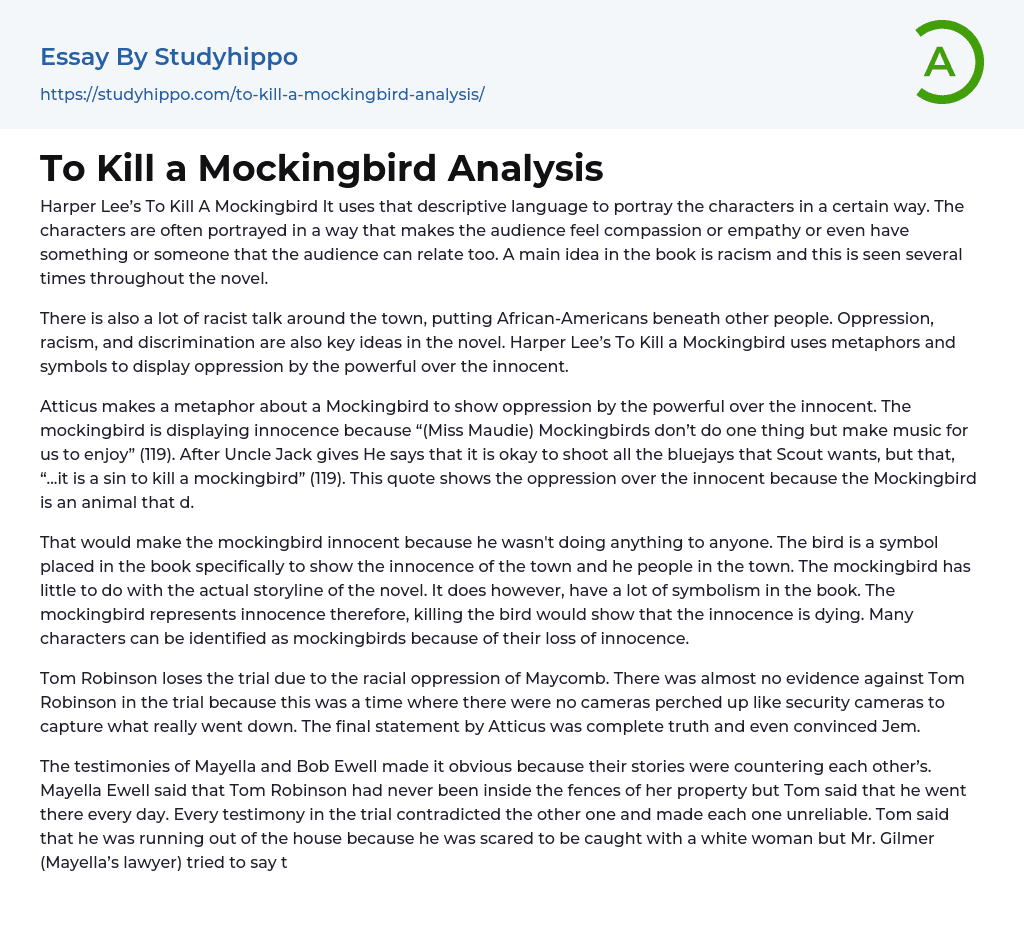Harper Lee's To Kill A Mockingbird utilizes descriptive language to depict its characters and evoke compassion, empathy, and relatability among the audience.
The novel, To Kill a Mockingbird by Harper Lee, explores the main theme of racism through various instances. Throughout the book, there are frequent instances of racist dialogue within the town, which highlights how African-Americans are marginalized. The core concepts of the novel also revolve around oppression, racism, and discrimination. Lee effectively employs metaphors and symbols to illustrate the domination of the innocent by the powerful. One such metaphor is used by Atticus, comparing the oppression to a Mockingbird.
The mockingbird is depicted as innocent because according to Miss Maudie, they only create music for our enjoyment (119). Uncle Jack also emphasizes that it is a sin to kill a mockingbird, implying the oppression faced by
...the innocent (119). This quote highlights how the mockingbird, a symbol representing innocence, is not harming anyone. Furthermore, the mockingbird serves to symbolize the innocence of the town and its inhabitants. Although unrelated to the main plot, the presence of the mockingbird reinforces this theme throughout the novel.
The book contains a significant amount of symbolism, with the mockingbird serving as a representation of innocence. Consequently, killing the bird is symbolic of the death of innocence. Several characters can be considered as mockingbirds, as they experience a loss of innocence. Tom Robinson is a prime example, as he is unjustly convicted in the trial due to Maycomb's racial oppression.
There was scarce evidence against Tom Robinson during the trial as this was an era without surveillance cameras to record the actual events. Atticus' concluding statement was profoundly truthfu
and even swayed Jem's opinion. The conflicting testimonies of Mayella and Bob Ewell clearly exposed the inconsistencies in their stories. Mayella Ewell claimed that Tom Robinson had never entered the boundaries of her property, while Tom stated he visited daily. Each testimony in the trial contradicted the others, rendering them all unreliable.
Tom mentioned that the reason he was running out of the house was because he feared the consequences of being caught with a white woman. However, Mr. Gilmer, Mayella's lawyer, attempted to argue that his actions were driven by wrongdoing. It should be noted that Tom Robinson faces physical limitations as he has only one arm and struggles to place his hand on a book. Despite these facts, the jury displayed clear prejudice and unjustly declared Tom Robinson guilty. His conviction was primarily influenced by racial bias.
In a society marked by rampant racism and discrimination against African Americans, the fact that the all-white jury presiding over Tom Robinson's case could potentially discriminate against him is not surprising. It was common practice in such times to treat blacks as inferior. This oppressive environment serves as evidence for Tom Robinson's innocence and his victimization by those in power. Similarly, Boo Radley's story exemplifies how innocence can be oppressed by the powerful.
Boo Radley has been confined to his own house for many years, both for his own safety and for the sake of the townspeople. He understands that if he were to venture outside, he would face discrimination due to his prolonged seclusion. Thus, to maintain contact with the outside world without risking oppression, he occasionally places small trinkets in a tree hole. One day, his brother
likely observes this act and, in order to safeguard their family and Boo, fills the tree hole with cement, feigning the death of the tree. Ultimately, Boo escapes his oppression and takes the life of Mr. Ewell to protect Jem and Scout from harm.
Boo Radley, an oppressed and misunderstood outcast of Maycomb, saves Jem by bringing him home to receive medical attention. The rumors about Boo, fabricated by town gossip Miss Stephanie Crawford and told to children, are unreliable and should not be believed. To Kill A Mockingbird is a book that employs descriptive language to evoke emotions in the text.
The mockingbird symbolizes innocence and oppression in the novel as it is unjustly targeted by a gun despite its innocence. Similarly, Tom Robinson is oppressed through a wrongful trial despite contradictory evidence and conflicting testimonies. Society oppresses Boo Radley as well, forcing him to stay indoors out of fear of discrimination and public harassment. Numerous rumors circulate about Boo, but only a few are true, with many being fabricated by the unreliable town gossip, Miss Stephanie Crawford.
- 1984 essays
- A Farewell to Arms essays
- A Good Man Is Hard to Find essays
- A Hanging essays
- A Lesson Before Dying essays
- A Long Way Gone essays
- A Rose For Emily essays
- A Separate Peace essays
- A Tale Of Two Cities essays
- A Very Old Man With Enormous Wings essays
- Adventures Of Huckleberry Finn essays
- Alice in Wonderland essays
- All Quiet on The Western Front essays
- Allegory of the Cave essays
- An occurrence at owl creek bridge essays
- Animal Farm essays
- Anthem essays
- Antigone essays
- Arthur Conan Doyle essays
- As I Lay Dying essays
- Atticus Finch essays
- Barn Burning essays
- Battle Royal essays
- Beauty and The Beast essays
- Beloved essays
- Boo Radley essays
- Brave New World essays
- Candide essays
- Castle essays
- Characters In Hamlet essays
- Characters In Romeo And Juliet essays
- Christmas carol essays
- Chronicle of a Death Foretold essays
- Cinderella essays
- Crime and Punishment essays
- Daisy Miller essays
- Death of a Salesman American Dream essays
- Desdemona essays
- Diary Of A Wimpy Kid essays
- Dracula essays
- Dubliners essays
- Emma essays
- Ender'S Game essays
- Ethan Frome essays
- Eveline essays
- Fahrenheit 451 essays
- First-Person Narrative essays
- Fish Cheeks essays
- Frankenstein essays
- Genesis essays




